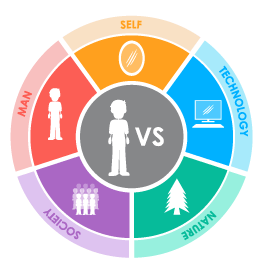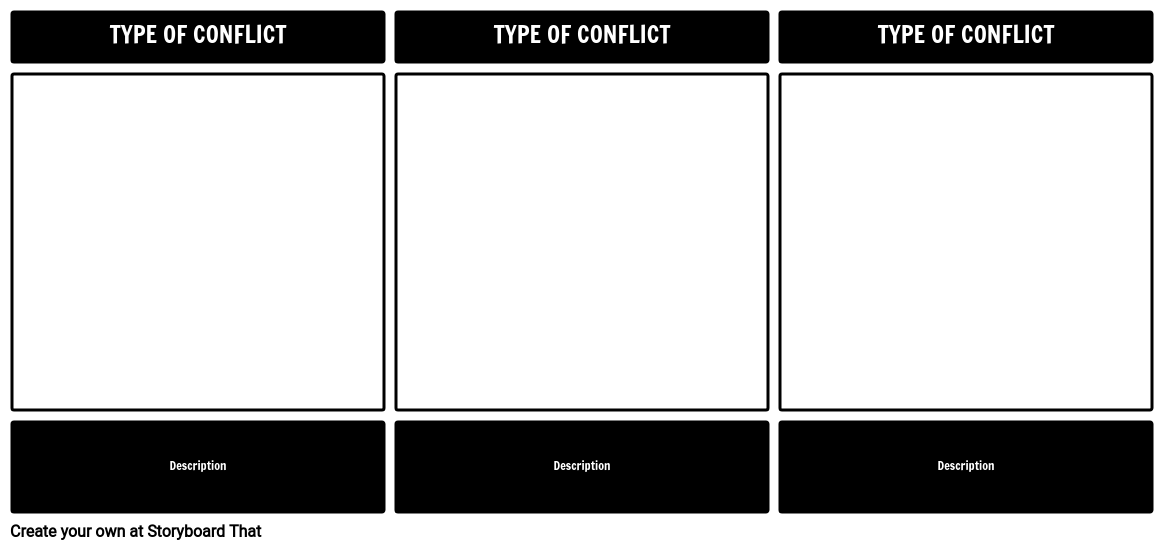Activity Overview
Storyboarding is an excellent way to focus on types of literary conflicts.
Having students create storyboards that show the cause and effect of different types of conflicts strengthens analytical thinking about literary concepts. Have your students choose an example of each literary conflict and depict them using the storyboard creator. In the storyboard, an example of each conflict should be visually represented, along with an explanation of the scene, and how it fits the particular category of conflict.
Examples of Literary Conflict
MAN vs. MAN
Amanda is constantly nitpicking at Tom: he eats too fast, he smokes too much, he doesn’t care about his appearance enough. After Amanda throws out some of Tom’s books that she finds questionable, Tom finally flips out on his mother. She claims that she thinks his “going to the movies” excuses are lies; Tom knows he does plenty for the family and he feels stuck, so he calls Amanda an “ugly witch” and storms out.
MAN vs. SELF
Tom feels trapped with his sister and his mother. He is 21, but he is the sole income for their family, and his sister does not seem able to get out of her own mind enough to make a life for herself. He wants to become a merchant sailor, to travel and see the world, but he knows that if he leaves, he will be abandoning them like their father did.
MAN vs. SOCIETY
Amanda has many ideas about where a young woman should be at a certain stage in her life. By this point, Laura should be married and starting a family; however, Laura is very shy and quiet. She enjoys her glass animal collection and playing the phonograph. She has no real interest in following a career path because she is too scared. She is not living up to her mother’s or society’s expectations for a woman her age.
Template and Class Instructions
(These instructions are completely customizable. After clicking "Copy Activity", update the instructions on the Edit Tab of the assignment.)
Student Instructions
Create a storyboard that shows at least three forms of literary conflict in The Glass Menagerie.
- Identify conflicts in The Glass Menagerie.
- Categorize each conflict as Character vs. Character, Character vs. Self, Character vs. Society, Character vs. Nature, or Character vs. Technology.
- Illustrate conflicts in the cells, using characters from the story.
- Write a short description of the conflict below the cell.
Lesson Plan Reference
- [ELA-Literacy/RL/9-10/3] Analyze how complex characters (e.g., those with multiple or conflicting motivations) develop over the course of a text, interact with other characters, and advance the plot or develop the theme
- [ELA-Literacy/RL/9-10/5] Analyze how an author’s choices concerning how to structure a text, order events within it (e.g., parallel plots), and manipulate time (e.g., pacing, flashbacks) create such effects as mystery, tension, or surprise
- [ELA-Literacy/RL/9-10/6] Analyze a particular point of view or cultural experience reflected in a work of literature from outside the United States, drawing on a wide reading of world literature
Rubric
(You can also create your own on Quick Rubric.)
| Proficient | Emerging | Beginning | Try Again | |
|---|---|---|---|---|
| Conflict Identification | Student identifies correct major conflicts and uses strong, clear textual evidence to support choice. | Student identifies correct major conflict and uses few or unclear details to support their choice. | Student identifies incorrect major conflict, and uses some details from the text to support their choice. | Student does not attempt to identify major conflict or identifies incorrect major conflict with no explanation. |
| Understanding Outcome | Student clearly shows the outcome of the conflict and its effects on the protagonist with evidence from the text. | Student shows the outcome of the conflict and its effect on the protagonist, but some evidence is unclear. | Student shows the outcome of the conflict, but does not examine its effect on the protagonist and uses some vague textual evidence. | Student does not clearly show the outcome of the conflict or use textual evidence. |
| Character | Storyboard includes all required characters and clearly names them. Goes above and beyond by adding additional details. | Storyboard includes all required characters and clearly names them. | Storyboard includes protagonist and antagonist but leaves out other required characters. | Storyboard does not include the names of required characters. |
| Storyboard | Student clearly shows effort to convey the setting the scene of the book | Student attempts to convey setting and scene of the book, but lacks some clarity. | Student does not clearly convey the setting and scene. | Student makes little or no attempt to convey the setting or scene. |
| Spelling and Grammar | Student uses exemplary spelling and grammar. There are no errors. | Student makes a minor error in spelling and grammar. | Student makes several minor errors in spelling and grammar. | Student makes many errors in spelling and grammar; little attempt at spellchecking. |
More Storyboard That Activities
Glass Menagerie, The
© 2024 - Clever Prototypes, LLC - All rights reserved.
StoryboardThat is a trademark of Clever Prototypes, LLC, and Registered in U.S. Patent and Trademark Office










